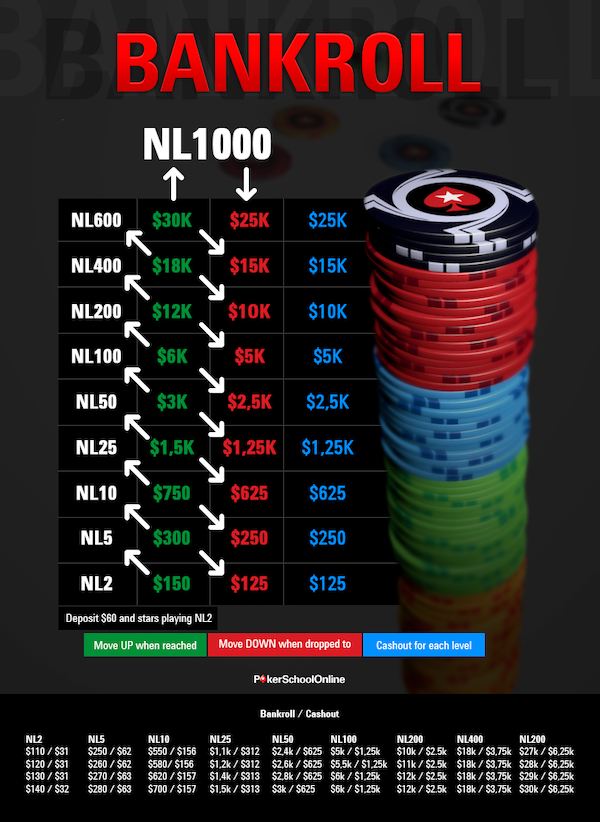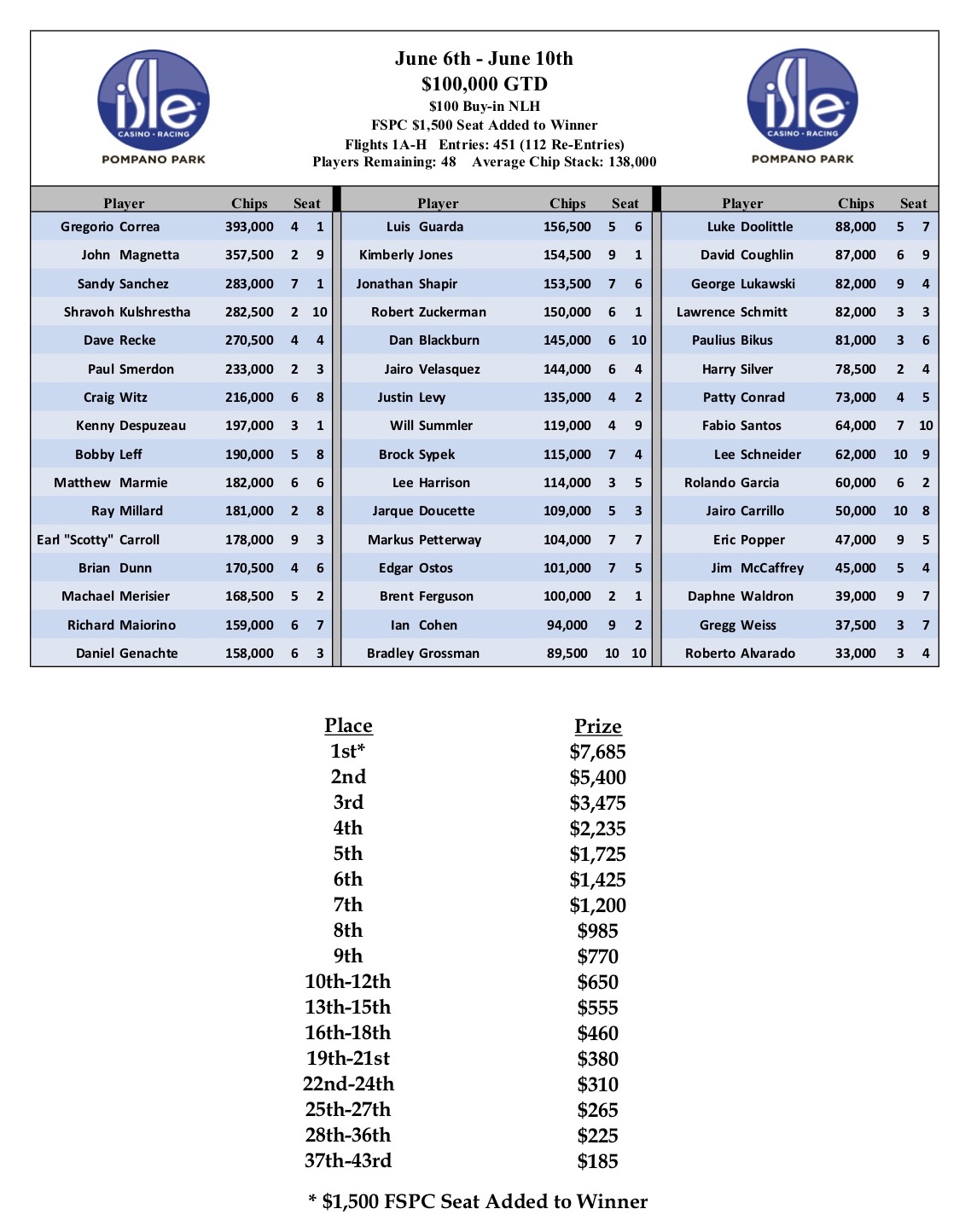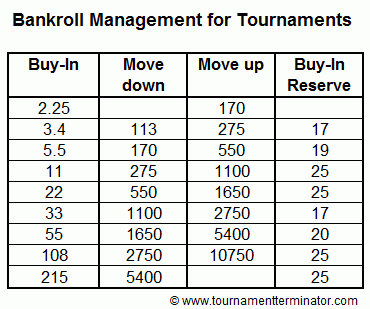Limit Poker Bankroll
- +1 for asking about of one of the most important poker skills, which is widely misunderstood and receives far too little attention. Also, note that many answers/comments contain advice to have a 200 big blind bankroll for Limit Hold'em. This is FAR too small and would only be suggested by players that are not serious LHE players.
- The golden rule when determining your bankroll is that it should amount to ten times the player's average bet. Breaking the bankroll into smaller amounts depending on the number of the betting sessions is also a good idea. In addition, players could change machines instead of wasting their entire bankroll on the same slot.
- Limit Poker Bankroll
- 1-2 No Limit Poker Bankroll
- Limit Poker Bankroll
- Fixed Limit Poker Bankroll Management
- Limit Poker Bankroll Management
You aren’t going to worry about a bankroll for low limit heads up Pot Limit Omaha if you only play live poker, for example. The guidelines for ideal bankroll management strategies are going to vary from player to player, but there are a number of dynamics that will remain relatively unchanged. The best poker bankroll management strategy for beginners is to have 50 buyins for any limit you are playing. Experienced poker players can get by with a bankroll of 30 buyins. And for professional poker players I recommend using a bankroll management strategy of 100 buyins for any limit you are playing. There is a lot more to it than this though.
Primarily a cash game player, poker professional Andrew Moreno also plays in tournaments including most recently finishing 28th in the 2015 World Series of Poker Main Event. We asked Moreno for some advice about bankroll management, and he provided the following short guide of useful advice on the subject.
First, let me share a little about my live poker experience. Right after I turned 21, I immediately started playing live no-limit hold’em cash games at stakes of $1/$2, $1/$3, and $2/$5. I remained at those stakes for about nine years, going broke a handful of times along the way and even getting a job for one six-month stretch. Then for the last three years, I’ve switched to primarily $5/$10 NL.
I have learned a great deal about what it takes to create and keep a proper bankroll, and I would love to share with you what I’ve learned over the years. For one thing, going broke is not the worst thing in the world — in fact, I have gone broke numerous times (though not in the last four years). In many ways it creates powerful awareness and gratitude for being able to play poker full time.
What Is the Right Bankroll for You?
In order for us to for create a proper bankroll, we need to establish a few things. Let’s start with some questions about yourself.
- What is your hourly rate? This is important because we need to establish how much you should expect to swing on a daily/weekly/monthly basis.
- How big is your sample size? Don’t get too up or down about your hourly rate before the first couple hundred hours. Your true hourly rate in live poker will not start to take shape until you’ve played thousands of hours (at minimum).
- What style of poker do you wish to play? If you wish to play on the looser side, you would need to account for more variance. If you wish to play a very straightforward TAG-style, you wouldn’t need to account for as much variance.
- What buy-in is allowed in your regular game? The buy-in usually varies from 100 to 200 big blinds for most live games. If you are you playing in 100 BB games, you should expect fewer swings.
- How do you handle emotional distress? Keep in mind that bankroll fluctuation comes with an emotional price. If you give yourself a short bankroll, you will experience wild emotional swings throughout each session until your bankroll reaches an amount with which you are comfortable playing.
- Are you able to be flexible and willing to drop down in stakes? For example, if you are playing $2/$5 and get down to a bankroll of $2,500 (5 buy-ins), you should really consider dropping down to $1/$3 NL.
Estimated Win Rates
For your convenience, I’ve estimated what I believe to be average win rates at each respective stake. These estimations are what I expect average winning players to win over the long term in these games.
- $1/$2 NL — average win rate: $15-$20 an hour
- $1/$3 NL — average win rate: $20-$25 an hour
- $2/$5 NL — average win rate: $25-$40 an hour
A general rule for where our bankroll should be is between 10-20 buy-ins. I would never recommend starting out playing on a bankroll of less than 10 buy-ins. If as a player you fall in the average category, I would recommend 15-20 buy-ins. If you are a very solid player and win above these rates, you can generally operate on a smaller bankroll as low as 10 buy-ins.
Other Bankroll Considerations
Here are a few other points to keep in mind as you try to be smart with bankroll management.
- Consideration #1: In low-stakes poker it is traditionally very difficult to exercise proper bankroll management.
Imagine we are sticking to 20 buy-in bankrolls each stake. That would mean $4,000 for $1/$2 NL, $6,000 for $1/$3 NL, and $10,000 for $2/$5 NL.
Now imagine breaking even for one month while our monthly living expenses are $2,000 for everything. In $1/$2 NL that is half our bankroll gone in expenses, in $1/$3 NL that’s one-third of our bankroll, and at $2/$5 NL that’s one-fifth our bankroll.
As you can see, the more we move up, the less our living expenses affect our bankroll.
- Consideration #2: When attempting to playing low-stakes poker for a living, your lifestyle needs to be as modest as possible.

I’ve seen so many poker players at all levels go broke due to poor decisions off the poker table. This is especially dangerous at the lowest stakes.
Moving up to $2/$5 NL is a stake at which you should be able to expect a fairly comfortable lifestyle if you can raise your game to beat it and reach that $25-$40/hour range. Try to find a good hybrid game to make the upward transition more smooth. Las Vegas has the Wynn $1/$3 NL with a $500 buy-in and the Bellagio has $2/$5 NL with a $500 max. buy-in.
- Consideration #3: Huge losing sessions are inexcusable and will destroy your bankroll very quickly.
One rule I follow is that I never lose in one session more than I can win back in one session. For example if my biggest win ever is $1,400, I won’t lose more than that in any single session.
- Consideration #4: Ideally, you never want to lose more than 10% of your bankroll in a single session.
We may be willing to risk more than 10% of our bankroll in amazing games. However, this should not be an excuse to put too much our bankroll on the table.
Cash Games and Buying In
I never recommend buying in for less than 100 BBs for a few reasons.
Limit Poker Bankroll
For one, when buying in for less we limit the amount we can win. Also, without proper experience, we put ourselves at risk when we start to run up our chip stack. In other words, we stunt our growth as a poker player. Playing short requires a totally different strategy and must be studied first before this strategy can be employed effectively.
You can consider buying in for more than 100 BBs if the game is amazing or one really terrible player is playing deep-stacked. However, we need to consider carefully whether we can afford to do so. We should be more inclined to buy in for more if our bankroll is 20 buy-ins or greater, but if it is less we may not be so inclined.
When deciding whether or not to buy in for more we should also keep in mind how we have been doing. If we are running well, we can take the risk of buying in for more. If we are running poorly, however, buy in for 100 BBs only. We don’t want to risk shaking our confidence too much when things are not going well.
When buying into a game also take note of whether or not you typically play deep-stacked and are comfortable doing so. If you are not confident, don’t buy in deep. Get coaching first and work on your game before doing this.
Tournaments
I have always approached tournaments very carefully. Ask any tournament pro about the swings they experience, and you may wonder why anyone plays them. However, I do enjoy tournaments and the allure of holding that winning lotto ticket is very attractive.
If you plan on playing a couple of cheap daily tournaments, you could use a small portion of your bankroll every now and then with minimal risk. As a general rule, I wouldn’t risk any more than 1/20th of your bankroll on any tournament you buy directly into. That means if you if you have a bankroll of $4,000, you wouldn’t play in any tournament with more than a $200 buy-in.
If you wish to play in tournaments that exceed this 1/20th rule, you could sell action to make up the difference. For example, say your bankroll is $4,000 and you want to play a $400 buy-in tournament — you would need to sell half your action so as not to commit more than 1/20th of your bankroll.
You can scale this model up and use it for any tournament. Lets say you want to play World Series of Poker Main Event that has a $10,000 buy-in. According to the 1/20th rule, you would need a bankroll of $200,000 minimum in order to play it responsibly on your own. By selling 75% of our action, you would need a $50,000 bankroll to play this tournament responsibly.
If you want to take “shots” in high value tournaments, do it responsibly. Use this advice as a guide and don’t deviate too far from it.
Keeping Records
I keep excellent records of my stats. I recommend keeping track of your results by using PokerJournal by Michael Golden or RunGood (for iOS). These apps are amazing for poker and have many easy-to-use filters to show you where you are winning and losing the most money. It is very simple — you just enter in your buy-in and the game/location, hit “start,” and then when you are done you hit “done” and enter in the amount with which you finished.
These apps aren’t cheap, but they are definitely worth it for any serious poker player. It is important to keep track of wins and losses for many reasons, including to have records for tax purposes. Beyond that we need to know if we are winning or losing and what games are the most profitable. I’ve had friends quit poker because they started tracking their results and saw that they were actually losing money when they thought they were winning players. The numbers don’t lie!
Once you accumulate a good amount of data about your play, there really is no end to the way you can analyze it. If you have leaks in your game, it is important for you to own them, define them, and then work to eliminate them. Keeping good records of your sessions and results can also help show you what games are best for you, and whether you are making correct decisions about staying and going.
For example, if you stay in games too long when you’re losing, you are actually using the inverse logic of successful poker players. In poker you want to stay in games as long possible when you’re winning, and you want to play not as long when you’re losing. If you don’t follow this rule you will be playing the least amount of poker when you’re hourly rate is as high as it can be, and you will be playing your longest sessions when your hourly rate is at its lowest. Your experience of poker also changes negatively when you play long sessions from behind.
Conclusion
Read this guide and use it to practice responsible bankroll skills. Operate as closely to the guidelines as you can, and you will find your bankroll will remain healthy and intact.
Want to stay atop all the latest in the poker world? If so, make sure to get PokerNews updates on your social media outlets. Follow us on Twitter and find us on both Facebook and Google+!
Tags
cash game strategytournament strategybankroll managementlive pokerAndrew MorenoRelated Players
Andrew Moreno
If you haven’t gone through our Poker Basics course, be sure to see this article on Intro to Bankroll Management.
1-2 No Limit Poker Bankroll
Poker Bankroll Management (BM) – what is it?
Bankroll is the amount of money which you decide to allocate to play poker (e.g. in your cashier on PokerStars). Bankroll Management allows you to decide how you use (manage) your bankroll. It is a very important skill but a lot of players ignore it. In this article you will find some tips how to do it well or better than before.
Remember: Bankroll is not the amount of chips you have at the poker table. This is called your poker stack.

1. Do not invest all your money in one tournament or cash game
When you play poker you should remember about variance and even though you might play well, you can lose the game. If you go all-in preflop with AA and someone calls with KK, in the long run you win in about 80% times, but in 20% you lose. So if you invest all your bankroll during this situation you will lose all your money every five times. To avoid this, try to invest only a small part of your bankroll in any one game.
2. Set your own target
Try to decide what do you want from poker. If you play just for fun from time to time you do not need a very big bankroll. But if you want to play more regularly you should decide to be more conservative, especially if you want to be a professional. Bankroll is your “tool” to work. If you lose all of it, you won’t be able to earn money.
3. Separate your bankroll from your other finance
When you set aside an amount that you have decided to play poker with it will be easier (you now know how much money you spend (on poker), and feel safer and more comfortable playing with it.
Remember: Do not spend money on poker that can get you into financial trouble!
4. Decide what kind of game you want to play
Limit Poker Bankroll
Cash games require different bankroll rules than Sit & Go’s or MTT’s. The same situation applies to “no limit”, “pot limit” or “fixed limit” games and also with “regular”, “turbo” or “hyper-turbo” tournaments.

Fixed Limit Poker Bankroll Management
5. Define your poker style
Limit Poker Bankroll Management
There’s no such thing as a ‘proper’ poker style and your strategy should depend on the situation on the poker table at the time. But probably you are able to define if you prefer tight or loose style and how aggressive you are. The looser and the more aggressive you are, the bigger bankroll you should have (because the variance is bigger).